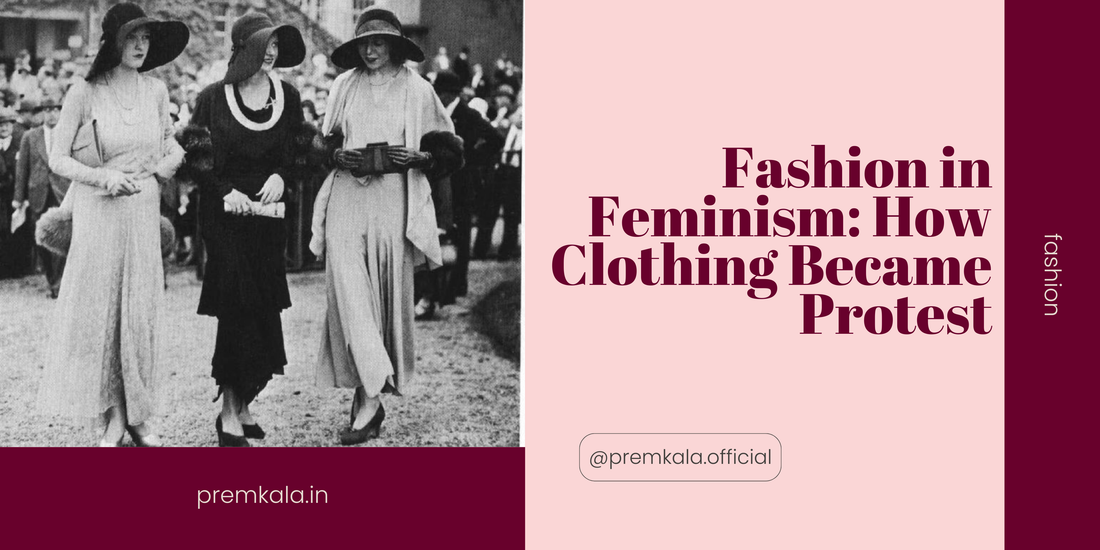
Fashion in Feminism: How Clothing Became Protest
Share
Fashion as a Voice of Feminism
Fashion has always been more than fabric and design—it’s a reflection of individuality, artistry, and the way we claim space in the world. Beyond the sparkle of runways and glossy editorials, clothing has often doubled as a subtle yet powerful weapon of defiance. For centuries, women have used style not only to express themselves but also to protest cultural expectations, political restrictions, and rigid social barriers. The story of feminism is incomplete without acknowledging how fashion has consistently shaped and amplified women’s voices.
When we think of feminism, images of rallies, raised voices, and landmark reforms often come to mind. Yet the quiet rebellion of clothing choices is just as central to this movement. What women chose to wear—or deliberately refused to wear—has repeatedly carried stories of strength, resistance, and transformation. Outfits are not mere threads and seams; they are woven with the spirit of resilience.
Fashion as Resistance Through History
Throughout history, garments have sparked movements, communicating change without a single word. In the late 19th century, suffragettes marched in carefully chosen white dresses. Far from being a fashion coincidence, this was a symbolic act: white represented purity, determination, and unity. It turned their protest into a striking visual force that demanded recognition.
By the 20th century, trousers emerged as another act of defiance. At a time when dresses and co-ord sets defined femininity, women who wore pants boldly challenged the patriarchal rules dictating behavior and appearance. What seemed like a simple wardrobe swap was in truth a loud declaration of independence.

Fashion Today: A Continuing Dialogue
Even now, fashion remains intertwined with activism. From slogan tees echoing political messages to sustainable fashion pushing back against exploitative systems, clothing continues to shape conversations around equality. Today’s movements remind us that style is not superficial—it’s strategic, intentional, and deeply personal.
My thought: fashion is feminism’s silent partner. It gives women the power to reclaim identity, to defy the gaze that seeks to control them, and to stand united in visual solidarity. Whether it’s a suffragette’s white dress, a pair of trousers, or a modern kurta set worn with confidence, every choice becomes a statement. Fashion may change with time, but its role as a tool of empowerment remains timeless.
The Political Power of Clothing
Clothing is often the very first marker society uses to define a woman. That makes fashion more than just self-expression—it is a political tool. From rejecting restrictive attire to embracing cultural identity with pride, fashion allows women to reclaim their narrative on their own terms.
Think of the sea of black gowns at the Golden Globes when Hollywood actresses stood together in support of the Time’s Up movement. That unified choice of attire spoke louder than words—it declared that silence and inequality would no longer be tolerated. Clothing, in that moment, was not about glamour but solidarity.
Ethnic wear has also been a quiet force of protest. Across South Asia, women have reclaimed sarees, kurtas, and traditional silhouettes at times when Western fashion was considered the only marker of “progress.” By wearing what is true to their culture, these women challenged narrow ideas of modernity and reminded society that progress isn’t about erasing heritage but redefining it with pride.
Everyday Fashion as Protest
Not all acts of protest happen on red carpets or in the streets. Sometimes, the most radical resistance is stitched into daily choices. A woman wearing bold prints in a conservative workplace, embracing her natural body instead of hiding behind unrealistic ideals, or mixing traditional wear with contemporary cuts—all these are quiet rebellions against rules meant to confine her.
Even small decisions, like rejecting outdated color taboos, choosing silhouettes that celebrate body positivity, or unapologetically dressing for one’s own comfort, become powerful statements. They remind us that feminism doesn’t always need a megaphone—sometimes it lives in the everyday outfit choices that tell the world: I define who I am.
Breaking Stereotypes Through Style
Fashion has long been a powerful tool in dismantling stereotypes about what women should or shouldn’t wear. For decades, society has dictated that short skirts were “inappropriate,” ethnic wear was “old-fashioned,” or only certain body types could pull off specific styles. But feminist fashion refuses to obey these rules. It insists that women have the right to define their own aesthetics, free from shame or restriction.
Today, women embrace everything from bold co-ord sets and sharp power suits to flowing anarkalis and simple cotton kurtas—with the same intention: to assert individuality. And that, in itself, is a feminist act. The beauty of it lies in choice. A Women kurta set with dupatta worn with pride can challenge stereotypes just as effectively as a mini dress or a business suit. This freedom of self-expression shows that style doesn’t belong to one narrative—it belongs to every woman.

Fashion and Identity in Modern Feminism
Modern feminism thrives on intersectionality, and fashion has become a visible stage for diverse voices. The industry, though slow to change, is learning to celebrate inclusivity—runways today feature plus-size models, campaigns highlight women of varied skin tones, and clothing lines embrace more adaptive and modest styles. This shift proves that beauty and power can’t be boxed into one mold.
Social media has accelerated this change by giving women everywhere the chance to reclaim their choices. Influencers and everyday women alike use fashion to fight sexism, body shaming, and cultural stereotypes. A woman confidently wearing a saree or hijab as an expression of her cultural pride is as feminist as another rocking jeans and crop tops. The common thread is not the garment itself but the agency behind it—the freedom to wear what feels authentic, without apology.
Clothing as a Symbol of Strength
The relationship between fashion and feminism is deeply rooted in the confidence clothing inspires. When women wear what truly empowers them, they project strength into the world. Sometimes that strength is quiet—like slipping into breathable, comfortable fabrics that allow freedom of movement. Other times it’s unmissable, like wearing a statement piece that demands attention and refuses to blend in. I believe both forms are equally powerful—because empowerment doesn’t always need volume, it only needs authenticity.
Ethnic wear has repeatedly proven its versatility in feminist movements. Whether worn during marches to honor tradition or reimagined through modern silhouettes, sarees, kurtas, and co-ord sets have helped women preserve cultural identity while sending a strong social message. To me, there’s something revolutionary about reclaiming traditional attire in a world that often equates “modernity” with Western styles—it’s a reminder that progress and heritage can walk hand in hand.
Fashion may appear superficial to some, but history paints a different picture. From suffragettes donning white dresses to today’s embrace of body-positive, Inclusive fashion, clothing has always been more than material—it’s a dialogue, a tool of resistance, and a canvas of empowerment. Every cut, fabric, and color chosen tells a story of resilience.
At Premkala, this belief shapes the very core of design. Fashion isn’t treated as just something to wear—it’s seen as a reflection of identity, confidence, and personal truth. A bold kurti, a flowing saree, or a playful co-ord set becomes more than an outfit; it becomes a declaration of individuality. And that, in my view, is where feminism and fashion beautifully merge—not in chasing trends, but in choosing clothing that makes women feel strong, seen, and unapologetically themselves.
Feminism and fashion will continue evolving together, but their bond will always remind us: clothing isn’t just about appearance; it’s about presence. It’s about walking into the world with the confidence to take up space and the courage to declare equality with every step.
